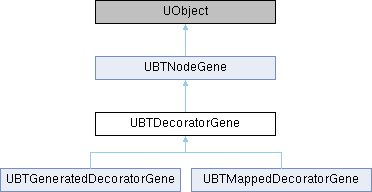
The abstract base class representing Decorators nodes. More...
#include <BTDecoratorGene.h>

Public Member Functions | |
| virtual UBTNodeGene * | Duplicate (UObject *outer) override |
 Public Member Functions inherited from UBTNodeGene Public Member Functions inherited from UBTNodeGene | |
| virtual void | SetServiceInjector (UServiceInjector *serviceInjector) |
Public Attributes | |
| virtual UBTDecorator * | BuildPhenotype (UObject *outer) PURE_VIRTUAL(UBTDecoratorGene |
| virtual UBTDecoratorGene * | DuplicateDecorator (UObject *other) PURE_VIRTUAL(UBTDecoratorGene |
 Public Attributes inherited from UBTNodeGene Public Attributes inherited from UBTNodeGene | |
| virtual FString | ToString () PURE_VIRTUAL(UBTNodeGene |
| virtual UBTNodeGene * | Duplicate (UObject *outer) PURE_VIRTUAL(UBTNodeGene |
Additional Inherited Members | |
 Protected Attributes inherited from UBTNodeGene Protected Attributes inherited from UBTNodeGene | |
| UServiceInjector * | ServiceInjector |
Detailed Description
The abstract base class representing Decorators nodes.
- Date
- 12/01/17
Decorator nodes sit on top of BTChildContainerGene's, which contain either a CompositeNodeGene or a TaskNodeGene. They can influence the way that those nodes execute in a number of ways, even stopping them from executing at all.
There are currently two subclasses:
BTMappedDecoratorGene: These are objects which map to templates for creating an Unreal Engine decorator node. Defaults are automatically set, and the only set up required is to add default nodes to the "NodeMapper" in the editor, or make sure the nodes you want are in there. We recommend using only mapped nodes until you are comfortable with the tool.
BTGeneratedDecoratorGene: These are objects which map to templates for creating an Unreal Engine decorator node. These nodes are based off the default Unreal nodes, sharing their base class, but must be "created" in the editor. This means going into the GeneratedTemplateLibrary and adding nodes. You must choose a name, class, and properties for each node. If your property names match those of the UClass you chose, the internal variables of the node will be mutated during the evolution process, giving an increased degree of control.
The documentation for this class was generated from the following file:
- Source/EvolvingBehavior/Public/Representation/BTDecoratorGene.h
